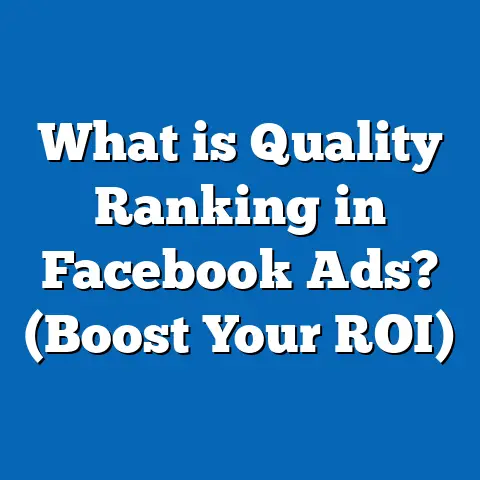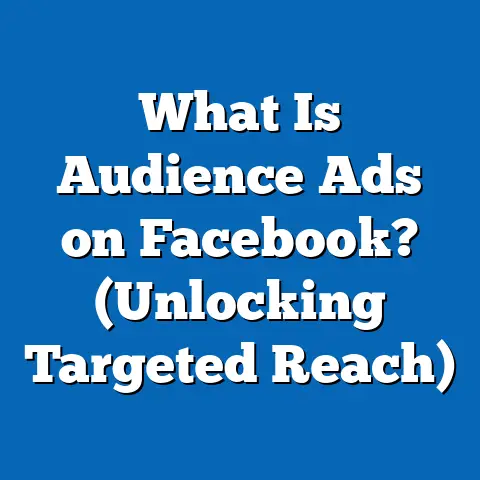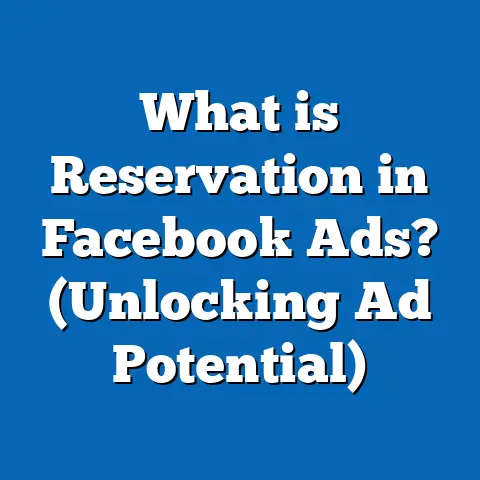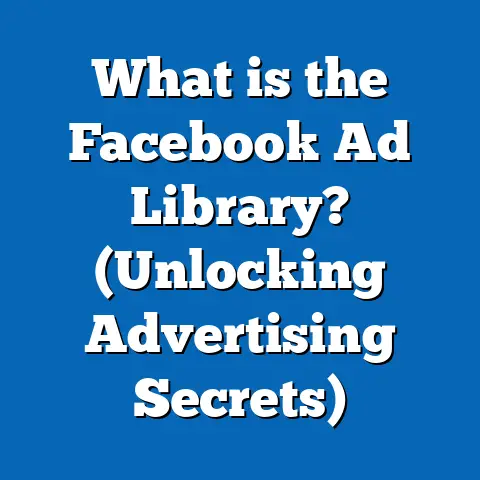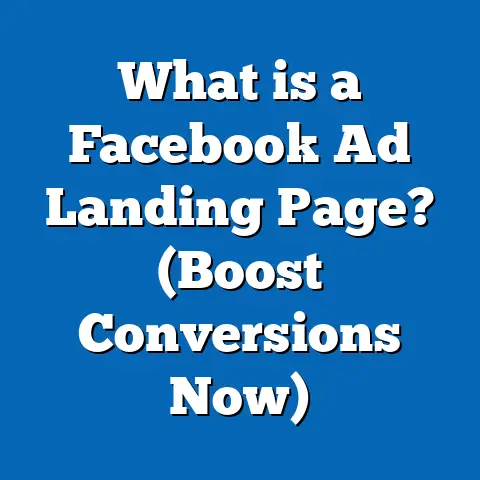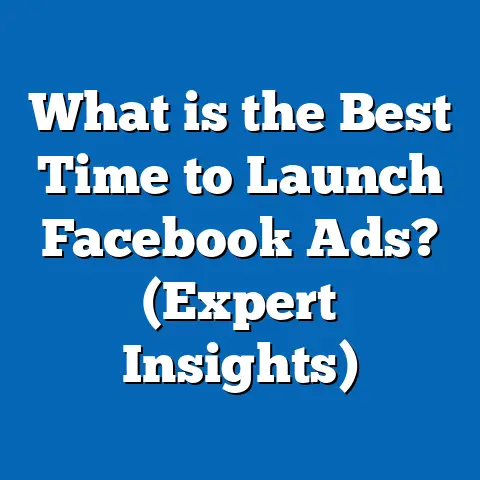What is Active Learning in Facebook Ads? (Unlocking Ad Success)
Introduction: Remember Your First Facebook Ad Campaign?
Remember the first time you launched a Facebook ad campaign? The excitement of selecting your target audience, setting a budget, and writing that perfect headline. You waited eagerly to see the results, only to find performance was inconsistent—some ads generated engagement while others fell flat. You may have tried tweaking your campaign, but the results didn’t improve as expected. This scenario is common among marketers and business owners new to Facebook advertising.
What you experienced is part of a complex process built into Facebook’s ad delivery system. Behind the scenes, Facebook uses a mechanism called Active Learning that helps optimize ad delivery by learning which audiences and placements yield the best results. Understanding Active Learning is key to managing expectations and improving campaign outcomes.
This guide will thoroughly explain Active Learning in Facebook Ads—from its fundamentals to advanced strategies—and provide actionable insights backed by data and real-world examples. Whether you are a marketing professional or a business owner managing ads yourself, mastering this concept will help you unlock the full potential of your Facebook ad campaigns.
What is Active Learning in Facebook Ads?
Detailed Definition
Active Learning is Facebook’s algorithmic process that occurs when you launch a new ad campaign or make significant edits to an existing campaign. During this phase, Facebook tests various audience segments, ad placements, and bidding strategies to gather sufficient data about which combinations deliver the best results.
Think of it as the algorithm “learning” who to show your ads to in order to maximize your chosen campaign objective—be it conversions, leads, app installs, or video views.
Why It Exists
Facebook’s ad delivery system relies heavily on machine learning models that need data to function effectively. When a campaign starts or changes drastically, the algorithm has limited information on how to optimize delivery. Active Learning fills this gap by experimenting with different delivery options to collect performance signals quickly.
How Active Learning Works Technically
- When you start a campaign or edit it significantly, the system marks it as being in the learning phase.
- Facebook distributes your ad impressions across various audience segments and placements.
- The system tracks optimization events (such as purchases or leads).
- Once around 50 optimization events occur within a 7-day window, Facebook deems it has enough data and exits the learning phase.
- After exiting learning mode, Facebook stabilizes ad delivery and focuses on showing ads more efficiently.
Learning Phase Indicator in Ads Manager
In Facebook Ads Manager, campaigns in learning mode are flagged with a “Learning” status. This is a visible sign for advertisers that performance may fluctuate and that it’s best to avoid changes during this period.
Why Active Learning Is Critical for Advertisers
Enhancing Campaign Efficiency
Active Learning allows Facebook’s algorithm to find the best-performing audience segments and placements faster than manual targeting alone could achieve. This means:
- Your budget is spent on audiences most likely to convert.
- You avoid wasted impressions on uninterested users.
- Results improve over time as the system refines delivery.
Data-backed Insight: According to Facebook’s internal benchmarks, campaigns that complete active learning successfully can reduce cost per conversion by up to 30% compared to campaigns stuck in learning mode or frequently edited.
Avoiding Costly Mistakes
Many advertisers misunderstand active learning and make premature decisions:
- They pause campaigns too soon.
- They make multiple edits resetting the learning phase.
- They switch optimization goals mid-campaign.
A survey from AdEspresso found that 56% of advertisers restart campaigns unnecessarily during the learning phase, leading to longer optimization times and higher costs.
Building Predictability into Your Campaigns
By understanding active learning, marketers can:
- Set realistic expectations about initial campaign volatility.
- Plan budgets and timelines accordingly.
- Make strategic decisions about when and what to edit.
The Mechanics of Active Learning Explained
Trigger Points for Active Learning
Active Learning kicks in at these moments:
- New Campaign Launch: Whenever you create a new campaign with an objective that uses Facebook’s conversion-based optimization.
- Significant Campaign Edits: Changes like adjusting targeting parameters, switching creatives, changing the campaign objective or optimization event reset learning.
- Budget Increases: Large increases (usually 20% or more) can trigger re-learning because the algorithm needs to adjust delivery to accommodate more spend.
- Ad Set-Level Changes: Edits at the ad set level—such as adding/removing placements or changing bid strategies—can also restart learning for that set.
Understanding Optimization Events and Their Impact
Optimization events are actions Facebook aims to drive (e.g., purchases, lead submissions). Facebook needs around 50 such events within 7 days to conclude the learning phase effectively.
- For example, if you optimize for purchases but your product receives only 10 conversions per week from ads, the learning phase will drag on.
- Conversely, optimizing for a higher-frequency event like “Add to Cart” or “View Content” can speed up learning but may not align perfectly with final goals.
Learning Phase Duration: What Affects It?
Learning phase length depends on:
- Event volume: Higher event frequency shortens learning time.
- Budget: Sufficient budget ensures enough impressions and events.
- Audience Size: Larger audiences provide more opportunities for delivery testing.
- Campaign Complexity: More ad sets or creatives mean more variables for Facebook to learn.
Typically, campaigns exit learning phase within 3–7 days if conditions are optimal.
Comparing Active Learning with Other Platforms’ Algorithms
Google Ads vs. Facebook Active Learning
Both platforms use machine learning but differ in scope and transparency:
| Aspect | Facebook Active Learning | Google Ads Machine Learning |
|---|---|---|
| Learning Phase Visibility | Clear “Learning” indicator in Ads Manager | No explicit learning phase indicator |
| Optimization Focus | Audience targeting & placement | Keywords, bidding strategies |
| Event Data Requirement | ~50 optimization events in 7 days | Variable; often requires more data |
| Edit Impact | Major edits reset learning | Edits may reduce performance but no clear reset |
| Budget Allocation | Campaign Budget Optimization (CBO) available | Smart Bidding adjusts bids dynamically |
Other Platforms: LinkedIn and TikTok Ads
- LinkedIn Ads: Uses machine learning but less transparent about active learning phases; optimization depends heavily on audience size.
- TikTok Ads: Uses automated delivery optimization; active learning concept exists but details are less publicized.
Facebook’s explicit active learning phase gives advertisers clearer signals on when their campaigns are being optimized versus when they should avoid making changes.
Practical Strategies: How to Work With Active Learning
1. Avoid Frequent Campaign Edits
Each major edit resets active learning. Plan campaigns thoroughly before launch:
- Finalize targeting.
- Complete creative testing outside main campaigns if possible.
- Set budgets and bids carefully upfront.
2. Choose Appropriate Optimization Events
Pick events with sufficient volume:
- For new campaigns: Optimize for high-frequency events like landing page views or add-to-cart actions.
- For mature campaigns: Optimize for purchases or leads when event volume supports it.
3. Set Adequate Budgets
Budgets should be large enough to generate approximately 50 optimization events within 7 days:
- Estimate based on historical data or industry benchmarks.
- Avoid underfunding campaigns that require significant time to exit learning phase.
4. Use Campaign Budget Optimization (CBO)
CBO lets Facebook automatically allocate budget across ad sets based on performance signals:
- Speeds up active learning by focusing spend on promising ad sets.
- Reduces manual budget adjustments that could reset learning.
5. Monitor Campaign Status Closely
Use Ads Manager to check if your campaign is in “Learning” status:
- Avoid making changes until it exits learning mode.
- Understand performance fluctuations as normal during this phase.
Deep Dive: Advanced Techniques Leveraging Active Learning
Employing Conversion API (CAPI) for Better Data Quality
Facebook’s Conversion API complements pixel tracking by sending conversion data directly from your server:
- Improves event accuracy by reducing data loss due to browser restrictions.
- Higher-quality data speeds up active learning by providing reliable signals faster.
Marketers using CAPI report up to 20% improvement in conversion tracking accuracy during the learning phase.
Integrate AI-Powered Creative Tools
Facebook’s AI tools automatically generate multiple creative versions for ads:
- Provides diverse assets during active learning.
- Helps algorithm test which creative resonates best without manual uploads.
This accelerates learning by expanding testing variables while requiring less manual effort.
Dynamic Ads and Catalog Sales Optimization
Dynamic ads show personalized products based on user behavior and catalog data:
- Leverage active learning by enabling rapid testing of different product-audience combinations.
- Useful for e-commerce brands with large catalogs needing efficient scaling.
Case Studies: Real Brands Unlocking Success Through Active Learning
Case Study 1: E-commerce Brand Cuts Cost Per Purchase by 28%
Background: A mid-sized online retailer struggled with high CPA ($45) on new product launches despite steady traffic.
Strategy:
- Switched optimization goal from landing page views to purchases.
- Increased budget from $500 to $1,500 per week.
- Used CBO across 3 ad sets targeting different audiences.
- Avoided editing campaigns after launch.
Results:
- Exited active learning in 4 days vs. previous 10+ days.
- CPA dropped from $45 to $32 within two weeks.
- ROAS improved by 35%.
Case Study 2: SaaS Company Accelerates Lead Generation
Background: SaaS company used Facebook Ads for lead generation but experienced erratic CPL (cost per lead).
Strategy:
- Optimized for “Lead” event instead of “Link Clicks.”
- Implemented Conversion API for better data tracking.
- Used AI creative tools for varied ad formats.
Results:
- Active learning completed faster with stable CPL around $12 (previously $18).
- Lead volume increased by 40% month-over-month.
Common Questions About Active Learning in Facebook Ads
How Long Does Active Learning Last?
Usually between 3–7 days depending on event volume and budget size. Lower event frequency extends this period.
Can I Speed Up Active Learning?
Yes. Increase budget responsibly, optimize for frequent events, use CAPI for data quality, avoid edits during learning phase.
What Happens if I Edit Campaigns During Active Learning?
Each significant change resets the active learning clock, causing delays and potential cost increases.
Is There a Way To Bypass Active Learning?
No official way exists because this process ensures Facebook’s algorithm delivers ads efficiently based on data-driven insights.
Summarizing Key Points and Next Steps
Key Takeaways
| Point | Description |
|---|---|
| What is Active Learning? | A testing phase where Facebook optimizes delivery based on early data |
| Duration | Typically 3–7 days |
| Event Threshold | ~50 optimization events within 7 days required |
| Impact of Edits | Major edits reset the process |
| Budget Considerations | Budget must support enough impressions for event volume |
| Tools That Help | CAPI, CBO, AI creative tools |
| Goal Selection | Optimize for realistic events relevant to your business |
Next Steps for Marketers and Business Owners
- Plan campaigns carefully before launch—finalize targeting, creatives, and goals.
- Allocate sufficient budget aligned with expected event volume.
- Use Conversion API and AI creative tools if possible.
- Monitor Ads Manager for “Learning” status; avoid unnecessary changes during this period.
- Analyze post-learning performance before scaling or editing campaigns further.
By mastering active learning principles, you position your Facebook ad campaigns for smoother launch phases and stronger long-term results.
Appendix: Additional Resources & Tools
Useful Tools for Managing Active Learning
- Facebook Ads Manager: Track real-time campaign status including “Learning” indicator.
- Facebook Business Help Center: Official documentation on active learning and campaign setup.
- AdEspresso Blog: Educational articles explaining common advertiser mistakes related to active learning.
- Google Analytics: Supplement Facebook data with site analytics for cross-channel insights.
If you want me to format this into a downloadable PDF guide or create a checklist for quick reference, just let me know!

